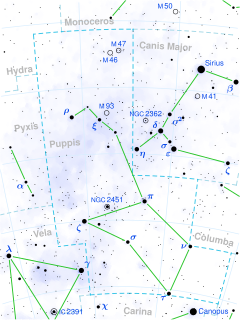K Puppis
| Observation data Epoch J2000.0 Equinox J2000.0 |
|
|---|---|
| Constellation | Puppis |
| k1 Pup | |
| Right ascension | 07h 38m 49.380s |
| Declination | −26° 48′ 06.49″ |
| Apparent magnitude (V) | +4.50 |
| k2 Pup | |
| Right ascension | 07h 38m 49.869s |
| Declination | −26° 48′ 13.80″ |
| Apparent magnitude (V) | +4.62 |
| Characteristics | |
| k1 | |
| Spectral type | B6 V |
| k2 | |
| Spectral type | B5 IV |
| Astrometry | |
| Distance | 454 ly (139.26 pc) |
| Absolute magnitude (MV) | -1.92 / -1.81 |
| Other designations | |
|
CD−26° 4707
|
|
| k1: HR 2948, HD 61555, SAO 174198, NSV 3673, HIP 37229 | |
| k2: HR 2949, HD 61556, SAO 174199, NSV 3673 | |
| Database references | |
| SIMBAD | k1 data |
| k2 data2 | |
k Puppis (k Pup, k Puppis) is a Bayer designation given to an optical double star in the constellation Puppis, the two components being k1 Puppis and k2 Puppis.
Note that the Bayer designation for this star is "k" not "kappa" (κ). In Bayer's original Uranometria, k Puppis was listed as ρ (rho) Navis. When Lacaille broke apart the large constellation Argo Navis into Carina, Puppis, and Vela, he re-designated the stars with greek letters in a single sequence across all three constellations. Additionally, Lacaille used Latin-script letters for many additional stars. κ (kappa) is in the constellation of Vela and so there is no kappa in Puppis. The confusion also extends to the proper name Markab which properly applies to κ Velorum (and ) but which has also been used for k Puppis when it is called κ Puppis.
Both k1 Puppis and k2 Puppis are bright blue B-type stars of nearly equal brightness, +4.50 and +4.62, respectively. To the naked eye, the pair has a combined magnitude of +3.80. On the sky, the two stars are separated by approximately 9.9 seconds of arc along PA 318°. The optical pair can be distinguished easily with a small telescope. The component k1 Puppis is a binary star system in its own right, while k2 Puppis is a variable star. Each star within the k Puppis optical pair is between 450 and 470 light years from Earth.
...
Wikipedia

